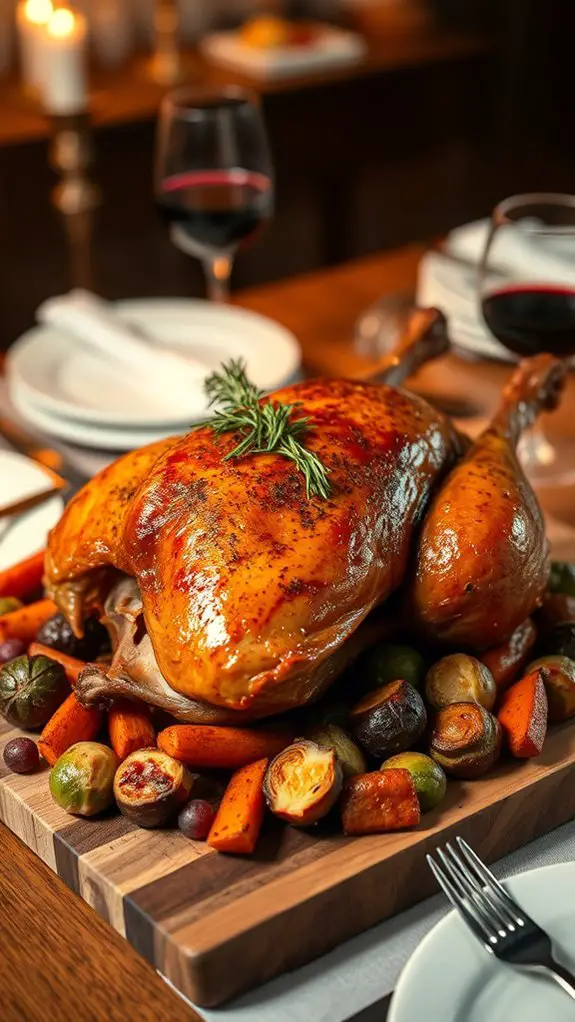You can't deny the allure of roast duck's crispy skin and rich, succulent meat. But have you considered the nutritional implications? While this classic dish delights the palate, its high calorie and fat content warrant thoughtful portion control. Explore the nuances of this centuries-old recipe, from its historical origins to modern-day preparation techniques. Uncover the delicate balance between enjoying this indulgence and maintaining a balanced diet.
History

Although an exact origin is unclear, roast duck has been a popular dish in Chinese cuisine for centuries. Its ancient origins can be traced back to the Sui Dynasty when roast duck was considered a delicacy.
Over time, the dish evolved as chefs experimented with different cooking techniques and seasonings. Today, Peking duck is one of the most renowned roast duck dishes, featuring a crispy skin and tender meat.
The culinary evolution of roast duck showcases the ingenuity and sophistication of Chinese cuisine, transforming a simple poultry dish into a celebrated gastronomic experience.
Recipe

Roast duck is a classic Chinese dish that's renowned for its crispy skin and juicy, flavorful meat. This recipe will guide you through the process of creating a delectable roast duck that's sure to impress your guests.
The key to achieving the perfect roast duck lies in the preparation. Proper drying and seasoning of the bird are essential steps that can't be overlooked. Additionally, the cooking method, which involves both roasting and steaming, is vital for guaranteeing the duck is cooked through while maintaining a crisp exterior.
Ingredients:
- 1 (5-6 pound) whole duck
- 1 tablespoon salt
- 1 teaspoon white pepper
- 2 teaspoons five-spice powder
- 2 tablespoons honey
- 1 cup boiling water
To cook the roast duck, first, pat the duck dry with paper towels and use a sharp knife to prick holes all over the skin. In a small bowl, mix together the salt, white pepper, and five-spice powder. Rub the seasoning mixture all over the duck, including the cavity.
Place the duck on a rack set over a baking sheet and refrigerate uncovered for at least 4 hours, or up to 24 hours, to allow the skin to dry out.
Preheat the oven to 375°F. Pour the boiling water into the baking sheet, being careful not to splash the duck. Roast the duck for 30 minutes, then reduce the oven temperature to 350°F and continue roasting for an additional 1 to 1.5 hours, or until the internal temperature of the thigh reaches 165°F.
Brush the duck with honey during the last 30 minutes of cooking to help create a glossy, caramelized skin.
To guarantee the most flavorful and tender roast duck, let the bird rest for 15-20 minutes before carving and serving. This resting period allows the juices to redistribute throughout the meat, resulting in a juicy and delicious dish. Enjoy your perfectly cooked roast duck!
Nutritional Guide
A single 6-ounce serving of roast duck provides a substantial 394 calories, along with impressive amounts of protein, fat, and essential vitamins and minerals.
As a protein source, roast duck is an excellent choice, packing 35 grams of high-quality protein per serving. The caloric content comes primarily from its 28 grams of fat, though a portion of this is the heart-healthy monounsaturated variety.
Duck is also rich in selenium, iron, zinc, and B vitamins. While the fat and calorie counts are higher than some lean meats, roast duck can fit into a balanced diet when consumed in moderation as part of an overall healthy lifestyle.
Final Thought
When considering roast duck as a dietary option, it's important to weigh the nutritional benefits against the relatively high caloric and fat content.
While roast duck can be enjoyed as part of a balanced diet, it's essential to employ appropriate cooking techniques and serving suggestions to maximize its nutritional value.
Portion control is key, as is pairing the duck with nutrient-dense side dishes.
Ultimately, roast duck should be approached with moderation, considering its place within the context of an individual's overall dietary needs and preferences.